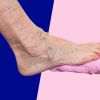How does diabetes affect vein health?

Diabetes is a chronic metabolic disease caused by abnormalities in the production or action of insulin, a hormone secreted by the pancreas. It belongs to the group of civilisation diseases, closely related to diet and lifestyle.
This ailment may take various forms, and the most common are insulin-dependent diabetes (type I) and insulin-independent diabetes (type II). The number of sufferers in Poland amounts to an average of 2 million people, of whom as many as one quarter are unaware. Research indicates that the incidence of diabetes will double over the next 15-20 years.
Causes, symptoms and treatment of diabetes
Type I diabetes, formerly known as "juvenile" diabetes, is most common between the ages of 10 and 14 and accounts for 10% of all cases. It is caused by a lack of insulin due to damage to the beta cells of the pancreas.
The causes can be attributed to the use of certain medications, viral infections, chronic stress, exposure to chemicals, and partly to genetics.
Symptoms of Type I diabetes include rapid weight loss, polyuria, excessive thirst, a constant feeling of fatigue, impaired concentration, reduced immunity, and even impaired consciousness.
Type II diabetes is the most common form of this disease and affects up to 90% of diabetics. It occurs most often in people over 40 years of age, the elderly and obese. It is characterized by disorders in both the secretion and action of insulin. It is conditioned by environmental and genetic factors.
Type II diabetes develops slowly and does not produce characteristic symptoms, which is why it is very often diagnosed years later.
In addition to the symptoms known from type I, there are disorders in wound healing, purulent lesions on the skin, blood circulation disorders, especially in older people (e.g. feeling of cold feet), impotence, vaginal inflammation, and itching of the skin.
Treatment of diabetes mellitus can take different forms depending on the type and course of the disease. In a few patients it is possible to control blood glucose levels with exercise and diet. However, most patients need oral anti-diabetic drugs and the vast majority must take daily insulin injections.
Diabetes - complications
If diabetes is not properly controlled, it can lead to numerous complications. The patient often suffers from annoying itching of the skin, diabetic erythema, excessive dryness of the skin, and is prone to fungal infections and yeast infections.
Other changes include wound infections in the feet, which are caused by damage to blood vessels resulting from circulation disorders, the so-called diabetic foot. The impaired healing of wounds and ulcers is evidence of progressive necrosis.
In addition, joints and bones are weakened, which can soon lead to deformation of the bones and consequently to problems with walking. Untreated diabetic foot usually results in amputation.
Varicose veins can also worsen the changes in the legs caused by diabetic complications. Impaired efficiency of deep and superficial veins of lower limbs causes worse blood outflow, which results in swelling and pain in lower legs. Problems with oxygenation of foot and lower leg tissues contribute to wounds and gangrene.
An important step is to determine the venous capacity and to assess whether complaints related to lower leg pain, swelling and cramps are caused by impaired blood outflow through the arteries or chronic venous insufficiency. This makes it possible to apply an appropriate pharmacological treatment or - optionally - using compression products.
Diet of a diabetic
A suitable diet is of great importance in the treatment of diabetes. Simple sugars should be eliminated from the diet and replaced with complex sugars with a low glycaemic index. It is also important to replace animal fats, such as lard and butter, with unsaturated vegetable fats - sunflower oil or olive oil.
The patient may eat lean cheese, yoghurt, pulses, potatoes, groats, rice, vegetables and some fruit and wholemeal bread every day. Two or three times a week it is permitted to eat poultry, eggs, lean fish and veal. Pork and beef are allowed up to three times a month.
It is also very important to limit salt. Salt can be replaced by herbs such as tarragon, thyme and lovage. Excess salt in the diet can lead to heart disease, heart attack and stroke, so diabetics need to be particularly careful with their diet.



















